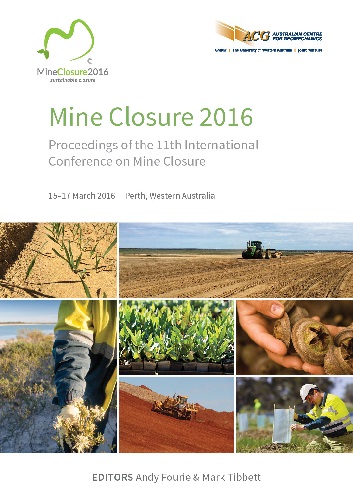Soil bioengineering and biomonitoring of vegetation and after-care at Wismut´s backfilled and covered Lichtenberg open pit and its surrounding area, Ronneburg, Germany

|
Authors: Barnekow, U; Köhler, M |
DOI https://doi.org/10.36487/ACG_rep/1608_39_Barnekow
Cite As:
Barnekow, U & Köhler, M 2016, 'Soil bioengineering and biomonitoring of vegetation and after-care at Wismut´s backfilled and covered Lichtenberg open pit and its surrounding area, Ronneburg, Germany', in AB Fourie & M Tibbett (eds), Mine Closure 2016: Proceedings of the 11th International Conference on Mine Closure, Australian Centre for Geomechanics, Perth, pp. 531-544, https://doi.org/10.36487/ACG_rep/1608_39_Barnekow
Abstract:
Since 1991 the state-owned Wismut GmbH has been remediating the legacies of former uranium mining in Germany. In the Ronneburg area, uranium mining, including underground and open pit mining, lasted from 1951 until 1990. The Lichtenberg open pit was mined out between 1958 and 1977 and partly backfilled by 1990. From 1990 to 2007, the open pit was completely backfilled and re-contoured by relocation of more than 130 million m³ of mine waste dumps located in the surrounding area. A thick cover (at least 1.6 m deep), consisting of loamy soils, was placed on nearly the entire re-contoured backfill area, thus creating a new landscape. Only a small disposal area for radioactively contaminated mine wastes currently still exists on the pit´s surface. Located next to the area of the Federal Horticultural Exhibition 2007 in Gera and Ronneburg, and the nearby town of Ronneburg (today with ca. 5,000 inhabitants), the newly formed hill ‘Schmirchauer Höhe’ competes with the highest natural hills in the surrounding area. The land use of the covered pit and its surrounds after closure includes forestation, grassland allowing for establishment of forest, open grassland and local park areas, barren land, wetlands and ponds. In addition, the re-use of the remediated mining sites in the surrounding area includes urban land use (dwellings), some industrial uses and renewable energy production with two large photovoltaic solar power plants that jointly cover ca. 37 ha. This paper presents the strategy and the steps for remediation including relocation of waste rock dumps for backfilling of the open pit and soil covering forming a new landscape. It puts specific emphasis on soil bioengineering strategies and methods applied for erosion control and establishment of vegetation (sowing strategies) in accordance with the requirements fixed in the accompanying landscape management plans for this and other sites. For about a decade, biomonitoring has been carried out on an annual basis, including biotope mapping and test pit excavations, to monitor the soil profile and root zone development in the soil cover over time. Based on the biomonitoring results, after-care measures have been implemented to allow and improve vegetation establishment and development. Nowadays some endangered species are colonising the newly formed habitats. The end of the remediation phase of the Lichtenberg open pit is a few years off. This allows for a preliminary review and outlook on the landscape development and its after use in the future.
Keywords: soil bioengineering, biomonitoring, erosion control, vegetation, after-care
References:
HAO 1980, ‘Anordnung zur Gewährleistung des Strahlenschutzes bei Halden und industriellen Absetzanlagen und bei der Verwendung darin abgelagerter Materialien‘, Journal of Laws, Directive of the German Democratic Republic, p. 347. [In German]
Schlüter, U 1996, Pflanze als Baustoff: Ingenieurbiologie in Praxis und Umwelt, Patzer Verlag Berlin, Hannover. [In German]
VOAS 1984, ‘Verordnung über die Gewährleistung von Atomsicherheit und Strahlenschutz‘, Journal of Laws, Directive of the German Democratic Republic, p. 341. [In German]
© Copyright 2025, Australian Centre for Geomechanics (ACG), The University of Western Australia. All rights reserved.
View copyright/legal information
Please direct any queries or error reports to repository-acg@uwa.edu.au
View copyright/legal information
Please direct any queries or error reports to repository-acg@uwa.edu.au